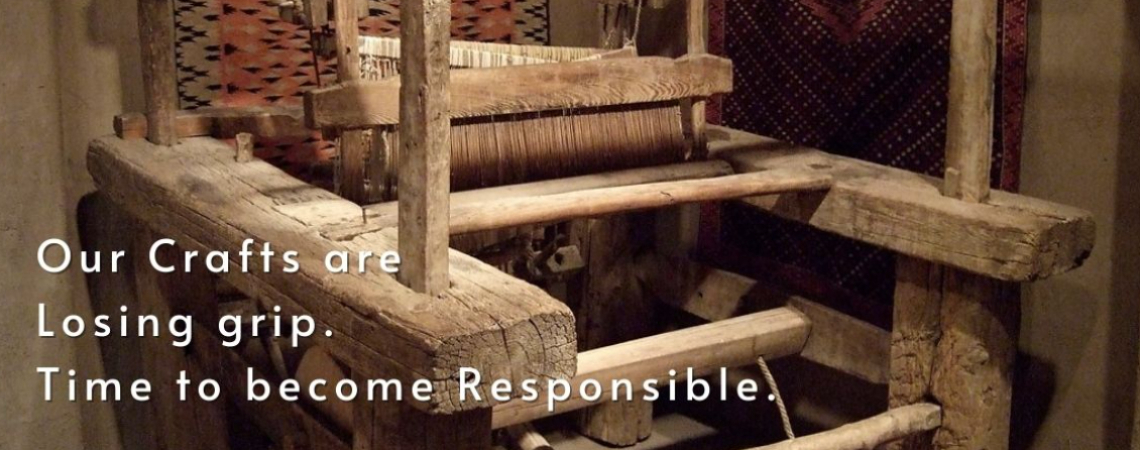India has a great treasure of indigenous handicrafts, earning it a desired place in global cultural history. These crafts range from the handwoven silks of Bengal to the tables of Ladakh that are engraved with dragons. Every carved jewelry box and embroidered shawl has a strong connection to the place where it was made. Traditional objects, which are deeply ingrained in local history, are more than just wonderful mementos; they are tiny periscopes into the geography and culture of a place. Our crafts are losing grip and it is Time to become more Responsible.
But today, the country that was formerly thought of as a melting pot of traditions and customs is increasingly losing its cultural identity as a result of globalization. Along with contributing to our cultural richness, these art forms provide the only means of support for many craftsman communities, which would otherwise be lost to destruction. But modernization and technological advancements are killing off many of India's traditional arts and crafts. These Indian handicrafts are in danger of going extinct since they are being supplanted by manufactured goods.
The Indian handloom industry is among the ones in danger. Handlooms were among the most exquisite textile traditions, and hand-spun and -woven textiles have played a significant role in the country's identity for many years. The silken rustle of a Banarasi sari has comforted and reassured generations of anxious brides. Yet tragically, it has become more and more difficult for weavers of such heirlooms to survive. The few people who still work in the industry use traditional jacquard looms made of wood. It is a rare treat to watch them meticulously weave the zari, which is typically made of real silver. The floral patterns, peacocks, paisleys, and chintz in the cloth have roots in antiquity and the middle ages, the era of the Mughals, and British colonial rule in India.
Power looms, which provide a less expensive and quicker means to produce goods that can take weeks for a weaver to accomplish in a day, are endangering the weavers' craft. Large areas of India's weavers' clusters are suffering as a result. A total of 31.44 lakh families, or 87% of all weaving-related households, are located in rural areas, according to the 2019–20 National Census of Handloom Weavers. In the late 1950s, competition from the power structures hastened the collapse of their already precarious way of life.
Similarly, the Rogan Painting is done only by 6 surviving people in India right now. The Rogan painting has been practiced by the Khatri family in the Kutch region of Rajasthan for seven generations, but they fear that this will be the final generation to do so because the next generation lacks the perseverance and tenacity to continue it. Castor oil, paints, and a 6-inch-thin metal rod are used to create this remarkable form of painting on fabric.
There are many more crafts which, if not taken proper measures, would be really difficult to revive or soon become history. We should understand the perks of products created using these crafts over machine-made ones. While the handicraft industry has a rich history, we must connect them to the twin realities of culture and economy because they not only represent Indian art but also serve as important sources of foreign exchange. They invoke the folklore, traditions, and history of the area. In addition to that, handicrafts radiate a feel-good vibe full of authenticity and uniqueness, which can’t be matched by millions of copies of a single item rolled out of the assembly line. They are made with the utmost care, compassion, and patience which is reflected in their quality and durability.
Thus, it is important for us, as responsible citizens and craft-bearers of this culturally vibrant country, to encourage craft and prevent it from becoming extinct. Though the government is taking measures to expand the lifespans of the crafts that are on the verge of extinction by giving monetary support, establishing craft communities, and conducting workshops, we as part of the society can also contribute our bit. We can buy handicrafts, gift them to our loved ones, share them on social media, and create awareness about them and their associated stories. These simple acts can boost the craftsmen’s confidence to a whole new level. They can be reassured that their craft is respected and valued, which is enough for them to continue pursuing it.
Preserving and protecting the skills and knowledge of traditional crafts is a growing challenge. So, it is a high time art forms are revived and awareness spreads in urban spaces. Here, at Megastores, the handholding approach to help artisans by simplifying their e-commerce journey has benefited many to comfortably go online. Also, it has been helpful in bringing awareness among the customers towards the crafts that are losing grip. Let's become responsible, and move towards a world where handcrafted items are given due respect and the artisans also get the recognition they deserve for their skills.











